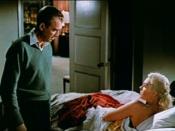Alfred Hitchcock was an auteur who relied upon a set of codes and conventions which made his films some of the most memorable ever made. He was primarily concerned with authorship in his films and tended to use dark fears and imaginative settings to attract the audience. For example this type of setting was used in the film 'Psycho'. The majority of the films that Hitchcock made were very similar and this is because he included specific motifs that were symbolic of him and his style. He would somehow incorporate these motifs into his films, sometimes in different ways, and they would form the base of which the film was to work on.
Hitchcock liked to keep the audience thinking and wanted viewers to in a way be confused at what he is trying to show only for it to be revealed at the end. It eventually would become clear in his films but only because the audience were so familiar with his trademark cinematography and mise en scene.
He was quoted as saying, "Always make the audience suffer as much as possible". And this he did do. One of the defining characteristics of most of Hitchcock's films was that he would make a cameo appearance. However because this would also become so familiar, he would make his appearance in the beginning of the films because he knew viewers were watching out for him. This way it wouldn't deviate their attention away from the story's plot and this typifies the regard that he had to the importance of a films plot.
In the film Vertigo, we see the image of Hitchcock at its best. The film opens with an ominous chase over the rooftops of San Francisco that leaves police detective John "Scottie" Ferguson (James Stewart) overcome with...


